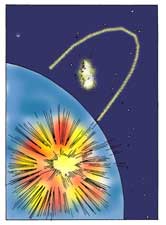
Dimdima
Online Children's Magazine from India

Dimdima
Online Children's Magazine from India

So far this century, two objects from outer space have struck the earth with enough force to destroy a whole city.
The first time it happened was in June 1908, when something fell out of the sky and exploded in Siberia near the Tunguska River. According to eyewitnesses, there was a blinding flash of light, followed by intense heat and then a ball of fire rose into the sky. Afterwards a black rain fell over the region. The explosion was several times more powerful than the one that flattened Hiroshima when the atom bomb was dropped on it in 1945. About 100,000 people died in Hiroshima. Tunguska being uninhabited, not a single human life was lost, but trees were scorched and uprooted over a vast area and scores of animals must have perished.
Nobody knows for sure what caused the Tunguska blast. At first it was thought that a meteorite had crashed to Earth, but no evidence of a meteorite crash was ever found in Tunguska. A large meteorite hitting the Earth creates a huge hole or crater at the point of impact. Famous examples are the Arizona crater in the Nevada desert of the USA and the Lonar crater in Maharashtra. No crater has been found in Tunguska. Some scientists say the object may have been a gaseous comet or an asteroid that exploded in mid-air.
A few scientists are of the view that the Tunguska blast could have been a nuclear explosion. The first to put forward this idea was a Russian scientist, Dr Kazantsev, who had made a thorough study of the Hiroshima bombing. He found similarities in the devastation caused in Hiroshima and Tunguska and came to the conclusion that the scale and pattern of destruction in Tunguska could only be explained in terms of a nuclear explosion.
Later he wrote a science fiction story based on the incident. In his story, a nuclear-powered spaceship from Mars develops serious trouble while flying over Earth. The commander of the craft knows that all is lost. He cannot save himself or his crew. All he can do is try to minimise the danger to the people on Earth. In a last manoeuvre he steers the spacecraft to a remote area of the planet and it crashes in the uncharted wilderness of Siberia.
The second time a large object from space fell to Earth was in 1947 — again in Siberia.
It was a meteorite. Hundreds of people saw a brilliant ball of fire speeding across the sky for a few seconds. Then it vanished from view and a pillar of brownish smoke rose into the atmosphere.
Later, investigators found pieces of meteoric iron strewn all over the Sikhote Alin mountains where it had crashed.
EXPLORE MORE...
Get Help or Give Help.
- Do you have a Science Question?
- Post it here and get the answer.
- Some questions posted by others are not yet answered.
- View those questions and answer them.
Dimdima is the Sanskrit word for ‘drumbeat’. In olden days, victory in battle was heralded by the beat of drums or any important news to be conveyed to the people used to be accompanied with drumbeats.
Bharatiya Vidya Bhavan
K. M Munshi Marg,
Chowpatty, Mumbai - 400 007
email : editor@dimdima.com
Bharatiya Vidya Bhavan
505, Sane Guruji Marg,
Tardeo, Mumbai - 400 034
email : promo@dimdima.com
Dimdima.com, the Children's Website of Bharatiya Vidya Bhavan launched in 2000 and came out with a Printed version of Dimdima Magazine in 2004. At present the Printed Version have more than 35,000 subscribers from India and Abroad.